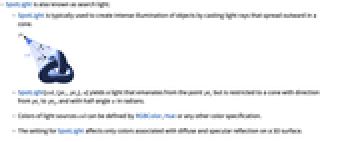SpotLight[col,pt,α]
is a three-dimensional graphics directive to use in coloring 3D surfaces that specifies the spotlight of color col at position pt aimed at the center with half-angle α.
SpotLight[col,{pt1,pt2},α]
uses the spotlight at position pt1 aimed at pt2 with half-angle α.
SpotLight[col,{pt,tar},{α,s},att]
uses the spotlight with spot exponent s and attenuation att.


SpotLight
SpotLight[col,pt,α]
is a three-dimensional graphics directive to use in coloring 3D surfaces that specifies the spotlight of color col at position pt aimed at the center with half-angle α.
SpotLight[col,{pt1,pt2},α]
uses the spotlight at position pt1 aimed at pt2 with half-angle α.
SpotLight[col,{pt,tar},{α,s},att]
uses the spotlight with spot exponent s and attenuation att.
Details


- SpotLight is also known as search light.
- SpotLight is typically used to create intense illumination of objects by casting light rays that spread outward in a cone.
- SpotLight[col,{pt1,pt2},α] yields a light that emanates from the point pt1 but is restricted to a cone with direction from pt1 to pt2, and with half-angle
 in radians.
in radians. - Colors of light sources col can be defined by RGBColor, Hue or any other color specification.
- The setting for SpotLight affects only colors associated with diffuse and specular reflection on a 3D surface.
- Light sources with color specifications of the form {dcol,Specularity[scol]} are effectively taken to have colors dcol for purposes of diffuse reflection and scol for purposes of specular reflection.
- Diffuse reflection is taken to follow Lambert's law, with light effectively scattered equally in all directions from a surface.
- Specular reflection effectively takes light to be scattered only close to the mirror‐reflection direction, as specified in the notes for Specularity.
- Light source positions and aiming points pti can be specified as follows:
-
{x,y,z} explicit coordinates that move with the graphic Scaled[{x,y,z}] scaled coordinates that move with the graphic ImageScaled[{x,y,z}] coordinates fixed relative to the final displayed image - In ImageScaled[{x,y,z}], the
 and
and  run from 0 to 1 across the width and height of the bounding box of the final displayed image. The
run from 0 to 1 across the width and height of the bounding box of the final displayed image. The  coordinate runs orthogonal to the plane of the display, and is 0 at the back of the 3D region and 1 at the front.
coordinate runs orthogonal to the plane of the display, and is 0 at the back of the 3D region and 1 at the front. - Coordinates specified in Scaled and ImageScaled will often not be between 0 and 1.
- SpotLight[col,{pt,tar},{α,s}] gives
 fall-off away from the center of the cone.
fall-off away from the center of the cone. - SpotLight[col,{pt,tar},{α,s},{a,b,c}}] gives
 attenuation with distance
attenuation with distance  .
.

Examples
open all close allBasic Examples (3)
Scope (7)
Lighting Specification (5)
Generalizations & Extensions (2)
Applications (3)
Possible Issues (2)
Related Guides
History
Text
Wolfram Research (2021), SpotLight, Wolfram Language function, https://reference.wolfram.com/language/ref/SpotLight.html.
CMS
Wolfram Language. 2021. "SpotLight." Wolfram Language & System Documentation Center. Wolfram Research. https://reference.wolfram.com/language/ref/SpotLight.html.
APA
Wolfram Language. (2021). SpotLight. Wolfram Language & System Documentation Center. Retrieved from https://reference.wolfram.com/language/ref/SpotLight.html
BibTeX
@misc{reference.wolfram_2025_spotlight, author="Wolfram Research", title="{SpotLight}", year="2021", howpublished="\url{https://reference.wolfram.com/language/ref/SpotLight.html}", note=[Accessed: 15-December-2025]}
BibLaTeX
@online{reference.wolfram_2025_spotlight, organization={Wolfram Research}, title={SpotLight}, year={2021}, url={https://reference.wolfram.com/language/ref/SpotLight.html}, note=[Accessed: 15-December-2025]}